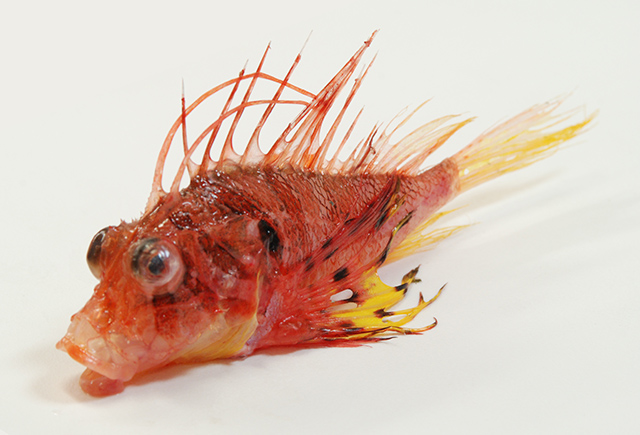| Scorpaenidae (Scorpionfishes or rockfishes), subfamily: Pteroinae |
| 11.6 cm TL (male/unsexed); max.weight: 15.0 g |
|
demersal; marine; depth range 47 - 243 m |
| Indian Ocean: off Somalia, Pakistan and the west coast of India and off the Andaman Sea coast of Thailand. |
|
Dorsal spines (total): 12-13; Dorsal soft rays (total): 10-10; Anal spines: 3-3; Anal soft rays: 8-10; Vertebrae: 24-24. Parietal crest of adult males very elongate; low in females. Dorsal fin rays 4.5-10.5; spines very long, longest at middle of the fin, 12th shortest; membranes deeply incised between spines; soft rays branched distally in largest specimens. Anal fin rays 7.5-9.5, usually 8.5; 1st spine shortest, increasing in length to 3rd; soft rays branched in larger specimens. Pectoral fin almost reaching caudal fin base, a little beyond in small individuals, short of caudal base in larger ones. Caudal fin very long , middle rays longest and branched; procurrent rays spinous. Vertical ctenoid scale rows about 40; cheek and area behind eyes scaled. Supraocular tentacle present. Preopercle with 3 spines; supplemental spine absent. Suborbital ridge spiny, irregular, with more than 10 spinous points of variable shape. Ocular ridges with spines, but poorly defined by location. Sphenotic and pterotic spines multiple. No spines on interorbital space, occiput, snout; no upper and lower post temporal, cleithral and supracleithral spines (Ref. 41422). |
|
|
Least Concern (LC); Date assessed: 20 June 2017 Ref. (130435)
|
| harmless |
Source and more info: www.fishbase.org. For personal, classroom, and other internal use only. Not for publication.

